2023 Summer Research Fellowships
Summer Research Fellowships provide summer support to doctoral students so they may focus exclusively on their dissertation research. The Summer Research Fellowship is intended to enable students to complete their degree more quickly and supports students who normally do not have funding during the summer. Thanks to many private donors, 33 graduate students are spending this summer focusing exclusively on their dissertation research. The students were selected for the quality of their work, their readiness to productively use the time this summer, and their mentors' willingness to work with them and provide guidance.
We’re pleased to present 33 Summer Research Fellowships for 2023 — and to share the honorees’ own descriptions of their research.
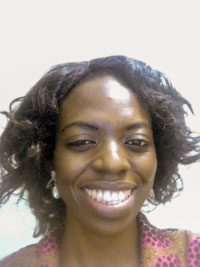
Dorothy Addo-Mensah
Nursing
“Prediabetes affects a considerable number of individuals in the United States of America, more than 1 in 3. Almost 40% of non-Hispanic Blacks have prediabetes. The risk of prediabetes is higher among African Americans than non-Hispanic white Americans. Approximately 70% of those with prediabetes will develop Type 2 diabetes within five years in the absence of an intervention. Researchers have made a great attempt to design and implement several behavioral lifestyle interventions for African Americans diagnosed with prediabetes based on the Diabetes Prevention Program (DPP). A similar intervention using a conventional diabetes risk reduction education program (CPD) and a mindfulness diabetes risk reduction education program (MPD) has been conducted to determine whether an MPD would reduce the risk of developing diabetes and stress and developing positive health behaviors.
However, it is not known which sub-groups and specific characteristics of an African American population (e.g., age, socioeconomic status) diagnosed with prediabetes may improve or not in a convention and mindfulness diabetes risk reduction program based on HbA1c cut-off point of less than 5.7% or a reduction of 0.5% in HbA1c levels. My dissertation seeks to find answers to these questions. Neither are the patterns of clinical outcomes and experiences of participants explored to recalibrate future intervention programs. This dissertation will further explore the group cohesion and credibility of participants who participated in both interventions. The results of the study will highlight potential elements to observe when planning a behavioral lifestyle intervention for African Americans with prediabetes.
One of the highlights of the dissertation is the use of a systematic review approach to synthesize data from studies assessing the components and clinical outcomes of behavioral lifestyle interventions designed for African Americans diagnosed with prediabetes. Despite all these interventions, it's not known the components and the patterns of clinical outcomes of African Americans in the United States of America enrolled in such interventions, whether the intervention is done in the community, in a hospital setting, or either delivered online or in person or its effectiveness for each sub-group.
Data to be analyzed will include primary (HbA1c and Fasting Plasma Glucose) and secondary (weight, Body Mass Index, waist-to-hip circumference or ratio, blood pressure, lipids, attendance to sessions) outcomes. I will analyze subgroups such as male and female and young and elderly participants in the study. This study is significant to healthcare research, education, practice and policy in improving the quality of life of Americans diagnosed with prediabetes.”
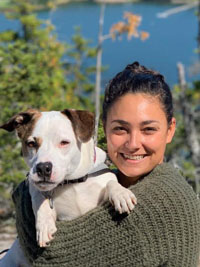
Madelaine Azar
Anthropology
“Building upon existing archaeological scholarship on ancient indigenous art in the American South, my dissertation examines the political and religious significance of decorated pottery produced by American Indians in the central Mississippi River valley (CMV) during the fourteenth and fifteenth centuries (1350-1550 CE). Throughout this time, Native towns in present-day southeast Missouri and northeast Arkansas waged war against each other, likely inhibiting political centralization.
Within this political climate, CMV potters created thousands of intricately painted and engraved pottery vessels (i.e., bottles, bowls, and jars) that depict religious symbolism referencing the Native cosmos, spirit beings, and culture heroes. Commonly recurring images include abstract motifs like interlocking scrolls and swirl crosses as well as representational images of religious practitioners, monsters, and aquatic animals (e.g., fish, frogs, turtles, and waterfowl).
In this research, I couple analyses of pottery manufacturing techniques and vessel function, which provide information about the political factors affecting ceramic production and use in the CMV, with an interpretation of the symbolism depicted on these vessels — one which relies heavily on analyses of Native oral traditions in the American South. Using an overarching theoretical framework focused on contemporary American Indian philosophy, I hope to generate new insights into the articulation between political structure and religion in the CMV. The Quapaw Nation and Osage Nation, who recognize ancestral ties to the CMV, have generously lent their support to this project.”
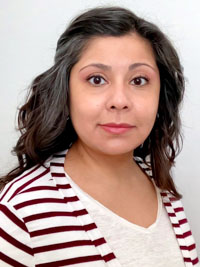
Stefani Baca-Atlas
Social Work
“Structural racism, defined as the cascade of historical and contemporary policies, rules, and practices that strengthen racialized inequities, is a determinant of health inequities. The relationship between structural racism and various forms of violence (e.g., community violence, killings by police) is well-documented; however, intimate partner and sexual violence (IP/SV) against people who identify as women is understudied. This area critically requires attention because IP/SV can compound historical, racial, and intergenerational trauma.
Further, complications associated with trauma promote health inequities by increasing the risk for chronic conditions such as hypertension, diabetes, and substance misuse, hindering the development of healthy parent-child relationships, and predisposing future generations to chronic conditions that are inherited from parents who experienced trauma. To prevent these inequities, research is needed that will address the root causes of IP/SV.
In my three-paper dissertation, I address gaps in the literature by examining how structural racism plays out in the lives of survivors of IP/SV. First, I am conducting a scoping review to understand the extent to which structural racism is addressed in studies of housing policy on post-victimization outcomes. I will also conduct secondary analyses using data from the National Crime Victimization Survey. Survey-weighted logistic regression and latent class analysis will be used to examine how structural racism impacts survivors with different identities. Findings are expected to provide insight into relationships between structural racism and unjust outcomes among survivors of IP/SV.”
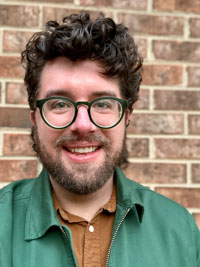
Codey Ryan Bills
Communication
“While ubiquitous today, the term "infrastructure" is a relative neologism in English. Early usage remained limited to descriptions of French railway projects in the early 20th century. After World War II, during NATO discussions about European reconstruction, "infrastructure" became increasingly common and referred to increasingly many kinds of systems. Even so, US governmental officials considered it a strange linguistic quirk of "foreign" European bureaucracies. In a curious reversal, however, by the 1990s "infrastructure" became central for the US government's security planning: certain large-scale sociotechnical systems, now always called infrastructure, became primary securable objects—and primary targets of 'threat.' To secure these critical infrastructures was to secure the nation as a whole.
My dissertation tracks the career of "infrastructure" in late 20th-century US security planning to put to question the term's relatively novel mundane centrality. Focusing on key moments at which "infrastructure" appears in US security policy demonstrates that the persistent value of the term is not in its function as a category. Instead, I show how "infrastructure" comes to signal the importance of some systems for the survival of certain abstractions—the government, the economy, and the nation—deemed necessary for the continued existence of the US. In the process, actually existing humans as they live within and beside infrastructural systems are reduced to functions of those abstractions and their survival to an accident of security planning.”
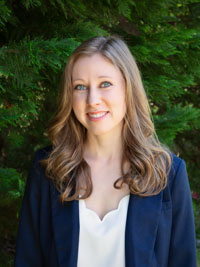
Elizabeth Bjornsen
Human Movement Science
“Rates of anterior cruciate ligament (ACL) injuries are rising in the pediatric population and have surpassed injury rates of adults. Engagement in high levels of physical activity and early sport specialization are likely contributors to increased ACL injury risk in pediatrics. Pediatrics are more likely to experience concomitant injuries and are at higher risk for graft retear in comparison to adults. In adults, the clinical focus is to prevent knee osteoarthritis development following an ACL reconstruction (ACLR). Yet, the clinical conversation for pediatric ACLR patients is often focused on a successful return-to-sport, with many patients and guardians unaware of possible long-term consequences following ACLR. Minimal research is focused on outcomes of pediatric patients following ACLR, highlighting the timely need for additional focus on an underserved community.
Aberrant walking gait biomechanical profiles and lesser limb loading magnitudes are strongly linked to early knee osteoarthritis development in adult patients following ACLR. However, walking gait profiles exhibited by pediatric patients post-ACLR have not yet been determined. My research seeks to determine 1) the limb-level walking gait biomechanical profiles and 2) the simulated magnitude of knee joint contact forces experienced in the ACLR knee during walking in pediatric ACLR patients in comparison to uninjured, pediatrics and adult ACLR patients. My research seeks to foster community engagement across North Carolina and beyond with the specific goal of generating developmental knowledge in pediatric ACLR biomechanics.”

Sarah Blanton
Romance Studies
“I explore the cultural production, artistic contributions and personal accounts of the farmworker community while considering the waves of social consciousness regarding transnational labor economies. We all depend on food to nurture us, but what we don't always remember is that the food comes from the hands laborers who cultivate and harvest it. My project focuses on the stories that are behind the produce purchased in grocery stores.
Here in North Carolina, as well as across the nation, laborers who harvest produce often come from Mexico and other Latin American countries to work in the agriculture sector, especially during the peak season. This project seeks out their stories. Each laborer has a family, history, talents and longings. By looking at farmworker narratives in literature, music, photography, ethnographies and unanticipated materials I find in the field, I hope to shed light on how lived experiences are communicated and the ways farmworkers exert agency and resistance in larger bureaucratic modes of labor and food production.”
Read more about Sarah Blanton's Summer Research Fellowship Experience.

Luke Conners
Mathematics
“I use tools from algebra, specifically representation theory of quantum groups, to study low-dimensional topology. Roughly speaking, topology is the study of "large-scale" geometric features that persists after gentle perturbations. Rather than measuring how dramatically a surface curves at a specific point, a topologist might study how many 2-dimensional holes that surface encloses. The phrase "low-dimensional" means I study 3- and 4-dimensional spaces, where there's just enough room to make things very interesting!
I'm most interested in knots, or closed circles that are tangled up in 3-dimensional space. When studying complicated spaces, like an arbitrary ambient 3-dimensional space, a common technique topologists employ is to use algebraic tools to describe some of their properties. Algebraic structures are often simpler to describe and manipulate than these spaces, so this often reveals simpler roads towards dramatic results. When studying knots, we can also run that program in reverse. Since knots are particularly simple objects to manipulate, we can use their properties to encode large, complicated calculations that would be prohibitively difficult to perform in their natural habitats. Our hope is to use these techniques to reveal bridges among disparate, but deeply intertwined, areas of mathematics such as algebraic geometry, mathematical physics, and representation theory.”
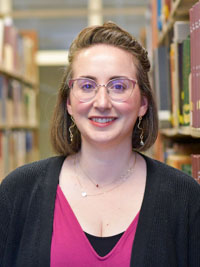
Sarah Farkas
Art History
“My project looks at two women who were alive in the mid-16th century, Anne of Cleves and her sister, Sibylle of Cleves. Anne of Cleves, the better known of the two, was the fourth wife of Henry VIII for a brief period until their marriage was annulled. Afterward, she lived the rest of her life as a very wealthy woman in England. Her sister, the Electress of Saxony, had an important political marriage and was a prominent figure in the German Reformation. Both are interesting because they left behind a large corpus of portraits as well as records of what they purchased, gifted and commissioned. I'm studying the ways portraits can convey individuals and the ways individuals use objects to say something about themselves, particularly with the background of the Reformation in Europe.”
Read more about Sarah Farkas's Summer Research Fellowship Experience.
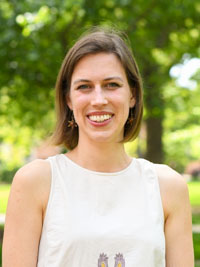
Rosemary Gay
Anthropology
“I am a sociocultural anthropologist focusing on agricultural science. I'm interested in why we farm the way we do, what science is conducted and implemented to support production, and how that influences what we eat. I'm studying a niche case of peanuts, specifically the peanut scientists working transnationally across the southeastern regions of the U.S. and of Brazil. I'm interested in how the research agenda of peanut science has evolved across time and space to become what it is today. I'm curious about the layers of power dynamics that influence what kinds of research on peanut science is conducted, and who benefits from it.”
Read more about Rosemary Gay's Summer Research Fellowship Experience.

Cortland Gilliam
Education
“Young people, particularly those who are not yet of voting age, tend to appear in academic scholarship and the greater political imaginary as incomplete, underdeveloped, adorable and accidental, yet potent, "pre-citizens". Black pre-voting-age youth, in particular, occupy an even more neglected, unconsidered, and, perhaps, unthinkable social-political position. Contrary to the dominant view, however, young people have been engaged in most major social and political movements for civil and human rights globally.
This dissertation is a historical and cultural study of Black, pre-voting-age youth contributions to political struggles and liberation movements in the U.S. South during the late twentieth century. With an eye toward the moment of school desegregation in North Carolina, the project uses state Board of Education archival data, existing and original oral history from former youth activists, and secondary historical texts, to (a) chronicle episodes of youth-led and participatory protests, political organizing, and resistance efforts; (b) illustrate how Black young people came to define, theorize, and practice resistance in relation to their political conditions and status; and (c) highlight how institutions of schooling during the desegregation era related to dissenting Black youth via education policy, rhetoric, and practice.”
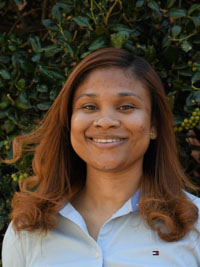
Ari Green
American Studies
“The emergence of Black geographies and Critical GIS attempt to level the playing field by giving Blackness spatial representation. In turn, Black people maintain their agency and ability to reconstruct the memory of a lost space. Katherine McKittrick's scholarship teaches us that Black geography is "subaltern or alternative geographic patterns that work alongside and beyond traditional geographies and operates as a site of terrain of struggle." When we place an emphasis or an importance on space that has been neglected, removed, and replaced — that once told the story of the Black Freedom Struggle — it allows us to lay bare how neglected and demolished institutions function as spatial indicators. And Black people must always negotiate for these places and spaces as they were once a space of denial and resistance.
My dissertation, "Systems of Erasure: How America Eliminates Black Spaces and Displaces Black Americans Through Public Policy," examines the relationship between race, space, and power by exploring the way policymakers and politicians at the municipal level respond to urban change by probing the issue of affordable housing. "Systems of Erasure," is a comparative analysis of three American cities that aims to capture the loss of Black space through the narratives of Black women and men whose lives have been socially, politically, and economically transformed by displacement during the 2008 Housing Crisis. I argue that every 30 years there is a reclamation of space by those in power and that displacement is directly linked to gentrification.”
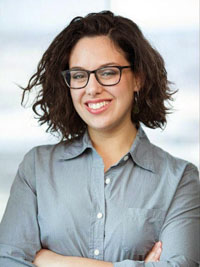
Hillary Hecht
Health Policy and Management
“People in bodies of all sizes are valuable, desirable, and deserve respect, autonomy, and high-quality healthcare. Weight stigma harms people in all bodies, particularly people in the biggest bodies and people who live in multiple marginalized identities. For healthcare to achieve a broad goal of providing equitable quality care to a diverse patient population, dismantling weight stigma through weight-affirming policies can promote safer, welcoming, participatory care spaces for people in all body sizes.
This three-aim doctoral dissertation uses both quantitative and qualitative methods to explore and define who experiences anti-fat bias, and how organizational policies respond to and prevent such bias in primary healthcare clinic settings. This project identifies the population of primary healthcare clinics which currently espouse explicit weight-affirming care goals. Interviewing clinicians and administrators explores employee perspectives on how their clinic describes and enacts weight-affirming care.
Collecting the documentation from each clinic — that is their practices, procedures, policies, training materials, patient facing communications, electronic health record templates, and additional materials — explores the mechanism of how clinics enact weight-inclusive care. An existing secondary dataset will elucidate the profiles of who most commonly experiences weight-based discrimination, and therefore who will most benefit from inclusive care policies. This work will contribute an organizational-level policy analysis to the current discourse about systemic oppression by perceived social identities in the U.S., focusing on body size identity.”
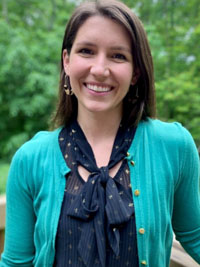
Emily Hutchens
Health Behavior
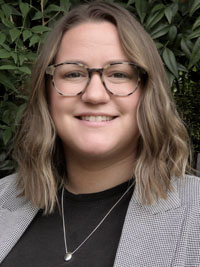
Caitlin Kearney
Education
“In my dissertation, I use sociological theories of organizations to examine the role of instructional coaches as tools for school improvement. As mid-level policy actors, instructional coaches have emerged as levers to implement reform policies and reduce academic disparities. District-level reforms that utilize instructional coaching often hinge upon divergent theories of action leading to the weak institutionalization of instructional coaching. With varied acceptance and implementation across contexts, additional research on the organizational conditions that drive effective instructional coaching programs — and successful efforts to scale them up — is needed.
To this end, I have formed a strong partnership with a large urban school district that experienced success using instructional coaching as a tool for school turnaround. In my dissertation, I examine the district's use of Covid relief dollars to expand instructional coaching to each of its more than 100 schools. Across three papers, I analyze 1) the district's theory of action for instructional coaching programs, 2) how school organizational contexts influence instructional coach practices, and 3) the relationship between instructional coach time use and student academic achievement. I utilize comprehensive administrative data on instructional coaches, teachers, and students as well as over 50 semi-structured interviews. Using a mixed-methods approach, I integrate quantitative and qualitative data through a convergent research design in order to investigate the empirical success of the instructional coaching program while also revealing the organizational dynamics shaping policy implementation.”

Jiyeon Kim
Sociology
“While direct care workers are one of the fastest growing occupations in the United States, many of these workers face difficulties finding stable employment. These care workers are predominantly women and racial minorities who are paid low wages. In 2022, the median wage for home health and personal care aides was $14, which was just half of the median wage of all occupations. In addition, many of these low-wage care workers work part-time in at least two jobs to piece together full-time employment.
What are the implications for gender and race inequality in the expanding care economy? In my three-paper dissertation project, I utilize longitudinal data to analyze (1) the impact of growing entry of male care workers on the wages of the industry over time and by geographic regions; (2) gender and racial/ethnic differences in the occupational and wage mobility of low-wage care workers; and (3) the role that holding secondary jobs has in shaping care workers' exit out of low-wage care jobs. By investigating these questions, my dissertation demonstrates the ways in which gender and race inequality manifests at the occupational- and individual-level in the care economy.”
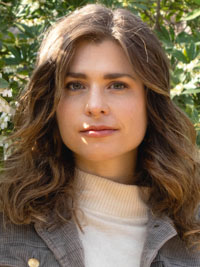
Jordan Klevdal
English and Comparative Literature
“My research examines the US American documentary photographer Walker Evans and his use of the term "lyric documentary" to describe his photography. I am particularly interested in thinking about Evans not just as a photographer, but as a writer. To do this, I am focusing on Evans's use of printed text (which he wrote himself or collaborated with other authors, such as James Agee) alongside his photographs, as well as his interest in objects that included images and writing (such as postcards). This summer, I spent a month in the Walker Evans Archives at the Metropolitan Museum of Art. I focused on his files on lyric documentary, his early attempts at writing and translating poetry, and his postcard collection (of which there are over 9,000).”
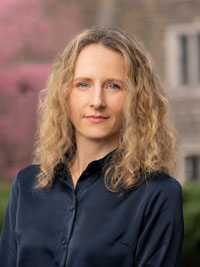
Andrea Larson
German Studies
“The figure of the muse has historically been gendered as a passive female, inspiring the male artist to creative output. My dissertation explores these gender dynamics in German-language lyric poetry, focusing primarily on the role played by feminine tropes in female-authored poetry of the last fifty years. I am particularly interested in the motif of the mirror, since poetic inspiration has historically often been figured in reflective terms: a female muse appears as a specular medium, into which the male poet gazes and by which he is transformed. My dissertation asks: what happens to this dynamic when women move out of the role of muse to occupy the space of the writing subject? How does lyric poetry as a genre engage with the generative concept of the feminine as reflective Other, once this Other starts to speak?
The muse figure has undergone dramatic changes over the last few centuries, but it has not disappeared. A diverse range of discourses continues to operate with gendered tropes trying to envision redemptive alternatives to a status quo perceived as problematically masculine. Theories on climate change, for example, frequently associate the feminine with the "oceanic" and equate this feminine-oceanic with an ecologically viable way of life. My dissertation takes a different approach, by examining texts in which the tropological binary itself becomes the problem, and the "solution" becomes a new practice of writing.”
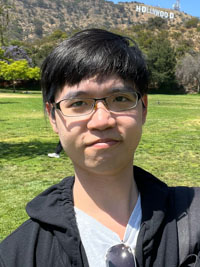
Tianqi Li
Economics
“What is the effect of high school graduation on wages? Does taxation effectively mitigate the emission of pollutants from factories? What would happen if companies merge in a market? Economists establish models with parameters and answer these questions quantitatively by using real-world datasets. While estimating impacts of interest, typically the parameters, it is often assumed that the parameters reside as an interior point within a set of feasible parameters, in order to better describe real-world scenarios. However, it is possible that some parameters are on the boundary of the set, suggesting potential model misspecification and challenges in statistical inference. This boundary issue is particularly intricate in the era of big data that researchers have access to highly detailed datasets with numerous characteristics available for modeling, which is referred to as high-dimensional problems in statistical literature.
My research project bridges the literature on boundary issues and that of high-dimensional problems. The methodology I propose is designed for the case that researchers are interested in a subset of parameters (i.e., the target) but are required to estimate the remaining parameters (i.e., the nuisance) as well. My framework accommodates situations that the true parameters are on the boundary and the number of parameters exceeds the sample size. Furthermore, I suggest a statistical testing procedure that is applicable to various models for identifying potential boundary issues.”

Kari Lindquist
Musicology
“In 1961, the University of Michigan Symphony Band embarked upon the longest US State Department–sponsored tour in history. The 94 musicians traveled throughout the Soviet Union, Middle East, and Eastern Europe playing 71 concerts in 30 cities over 15 weeks from February to June. With this tour as the focus, my dissertation brings the unique qualities of wind bands of the concert tradition into the discourse of Cold War musical diplomacy. A wind band is a group of woodwinds, brass, and percussion players without strings. I argue that wind bands performed a unique diplomatic function distinct from other ensembles because of: 1) their appeal to non-elite audiences, 2) their ability to perform outside and in large venues, and 3) their variety of repertoire from popular to classical. With these qualities, wind bands were able to broaden their diplomatic reach to diverse audiences.
Using archival materials and interviews with band members, I reconstruct the diplomatic significance of this tour completed by college students on such a wide international scale. Ultimately, the band used music of the American wind band tradition and music known to their international constituents to form the basis of the majority of the interactions on the tour. The University of Michigan Symphony Band's tour illuminates the role of wind bands to serve on behalf of the US through musical diplomacy during the Cold War era.”
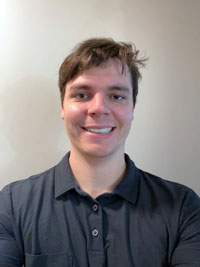
Aidan Mahoney
Classics
“My research explores how Plautus and Terence, the two major playwrights of Roman Comedy, represent female and subaltern (enslaved, lower class, sex workers) characters on (and off) the stage. The elite male perspective is the dominant one that remains from Greek and Roman literature, so Roman Comedy offers a glimpse at portrayals of characters outside of this privileged class. Plautus champions clever characters, especially the servus callidus—the enslaved trickster—and Terence heavily critiques the paterfamilias—the traditional head of the Roman household.
In my research, I study how Plautus plays with stage space to show how characters of lesser social standing are able to compete with and outsmart the male characters who hold most of the power in Roman society. Roman women were traditionally associated with interior, domestic space. In his plays, Plautus turns this space, rarely represented onstage but present offstage, into a source of power where female character manipulate the male characters to control the events of the play. More often than not, the male characters end up looking foolish while the female characters get what they want. Terence continues this trend but with an even more damning look at the male characters.
My research brings out the voices of these subaltern characters while also bringing closer attention to how the Roman playwrights manipulate and portray space on the Roman stage.”
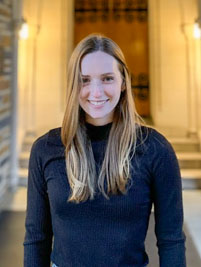
Mary Catherine Minnig
Epidemiology
“Osteoarthritis (OA) is a common and progressive joint disease associated with bone spur formation and cartilage thinning. Knee OA is the most common form of the disease and is currently incurable. Treatment options have thus far been limited to disease-related symptom management. Numerous potential disease-modifying OA drugs (DMOADs)—medications to slow or prevent further disease progression—have been tested in clinical trial settings, but none have been approved for use. The US Federal Drug Administration (FDA) recommends that measures obtained through radiography, or x-ray, be used to determine clinical trial participant eligibility and study endpoints. Such measures, however, provide a limited view of the joint and are insensitive to pathological changes that occur over time. It has been suggested that these limitations have contributed to the high failure rates DMOAD clinical trials, thus a reevaluation of trial procedures are needed.
Magnetic resonance imaging (MRI) offers a number of advantages to traditional radiography, including its ability to directly measure cartilage thickness. The introduction of novel machine and deep learning techniques make the use of MRI in large trial settings more feasible as data can now be efficiently extracted from large imaging datasets. My dissertation seeks to quantify the relationship between the standard radiographic measure of OA used in DMOAD clinical trials and a novel MRI-derived measure of disease. MRI may be an effective tool in DMOAD trial settings that ultimately leads to the approval of a medication to slow disease progression.”

Isabel Morgan
Maternal and Child Health
“Black women experience significant challenges in navigating fertility care and medically assisted reproductive technologies, including intrauterine insemination (IUI) and in vitro fertilization (IVF). Despite experiencing a higher prevalence of infertility, Black women are less likely than women of other racialized groups to utilize medically assisted reproductive technologies. Further, once infertility treatment is initiated, Black women have a greater risk of falling out of the continuum of care and infertility treatment pathways towards a live birth and experiencing adverse birth outcomes. Much of what we know about Black women's infertility treatment outcomes derives from the quantitative literature that asserts race as the sole or predominant predictor of success with infertility treatment, which lacks critical framing around underlying causes of reproductive health inequities.
Guided by reproductive justice and Black feminism, my dissertation research seeks to illuminate Black women's experiences traversing health care systems to access and obtain fertility care and infertility treatment ranging from basic fertility testing (e.g., AMH levels) to in vitro fertilization (IVF), with particular emphasis on contextualizing circumstances surrounding reaching specific infertility treatment milestones. Additionally, this research aims to examine the ways in which Black women perceive the causes of their fertility challenges, and how these perceptions may impact the types of infertility treatment modalities pursued.
To address these research aims, I analyze 60 transcripts from interviews conducted with 41 Black women about their fertility challenges. Qualitatively examining Black women's perceptions about the causes of their infertility and fertility treatment experiences may provide insights that contextualize treatment pathways and outcomes (e.g., reasons for cycle cancellations) observed in epidemiologic analyses.
Further, the learnings from this research may also offer insights for policy advocacy to address structural factors that influence Black women's fertility experiences and outcomes, and the ways in which sexual and reproductive health education can be strengthened to address Black women's understandings about the causes and treatments for infertility.”
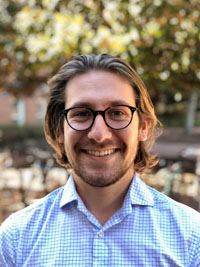
Martin Naunov
Political Science
“In my research, I explore whether, how, why, and to what effect people's responses to political agents—such as politicians, protesters, and plaintiffs—vary based on characteristics related to the targets' gender, sexual orientation, race, and ethnicity. Research in political science on stereotyping and prejudice has overwhelmingly focused on documenting people's reactions based on a target's membership in some superordinate, census-style identity category—experimentally examining, for instance, differences in voters' evaluations of hypothetical political candidates depending on whether the candidate is identified as "Black" or "white", "gay" or "straight", "male" or "female".
A major facet of my research agenda centers on offering empirical evidence that disaggregating discrete, census-style identity categories and studying biases at the level of subcategories is essential to more accurately capture and understand the disparate reactions and treatment faced by members of historically stigmatized groups. In doing so, my research also showcases the power and promise of using audio data and vocal experimental stimuli in studying biases, discrimination, and socio-political inequalities.”

Emily Ommundsen
Political Science
“Members of Congress run for office with a variety of goals they hope to achieve if elected. In my dissertation, I assess the personal qualities and institutional circumstances that motivate members' operational decisions, which reflect their representational priorities. I find that members who spend a greater proportion of their budget are more effective lawmakers than those who do not spend their full budgets. Further, I demonstrate that members who invest more in legislative staff have the highest rates of legislative productivity. I extend this theory to committee chairs and the choices they make as they run their committee office. Using data on Senate staff experience and a new measure of committee productivity, I find that a committee's average years of staff experience is a significant predictor of committee legislative effectiveness.
Lastly, I consider how the choices first-term members make as they establish their congressional offices affect their future legislative operations. I argue that members who generally lack preexisting relationships with other members of Congress, especially first-term members, compensate for this lack of social ties by making strategic hiring decisions and relying on the social networks of their staff.
Members of Congress make strategic choices in how they divide their budget and set up their offices. My dissertation demonstrates that investing in the institution and institutional knowledge is a wise strategy for members desiring legislative success.”
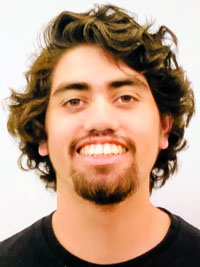
Carlos Serrano
Geography
“Focusing on my hometown of Miami, Florida, my research begins with the aftermath of what is known as the McDuffie Rebellion of 1980, when the police officers who murdered a Black man named Arthur McDuffie were acquitted of charges. I not only place this moment of protests in the context of Black struggles for justice in the United States, but I also contextualize this moment with Cold War politics and Ronald Reagan's neoliberal revolution that led to the further underdevelopment of Black neighborhoods in the country. In Miami, we also witnessed tension between racialized groups: Black residents and Spanish speaking immigrants and between white Spanish speaking immigrants and Black Caribbean immigrants. Within this framing, I approach Miami as being a US Southern city and an extension of the Caribbean and Latin America.
Using a range of methodological approaches such as ethnographic fieldwork, participant observation, and archival research, I ask: how do cities and residents understand and address the relationship between policing and the redevelopment of neighborhoods? How is this linked to US geopolitical ambitions? Using the aftermath of the McDuffie Rebellion up to present, I trace and juxtapose anti-Blackness, police violence, and histories of displacement and gentrification to analyze how these intertwined sources of systemic violence are a fabric of US cities.”

Wenzheng Shi
Materials Science
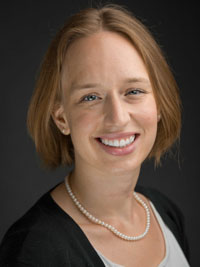
Madeleine Straubel
Sociology
“From redlining to gentrification, persistent racial inequality plagues American neighborhoods, as one facet of structural racism, or how race structures societies. To understand structural racism in neighborhoods, we must further study the dominant racial group, White Americans, including how they experience the benefits of Whiteness and how they contribute to racial inequality.
Prior research finds that White Americans use non-racial explanations to justify racial inequality, like explaining racial segregation as due to people's natural preferences. However, some White Americans are now more versed in racial inequality and yet most do not spend their resources to challenge structural racism and build a racially just and equitable society. My dissertation examines White racial identities to understand how and when White people experience themselves as raced, as well as the justifications they pose for racial inequality, that is, the racial ideologies that reconcile their knowledge with their inaction.
To understand these facets of structural racism, I interviewed and observed White residents of two gentrifying neighborhood types, those with majority-White and with majority-Black populations. My findings 1) identify variations in White racial identities, 2) update racial ideologies theory to account for White Americans' increasing awareness of racial inequality, and 3) links research on identities and ideologies to identify the types of White people most inclined to anti-racist action, as well as effective levers for and potential barriers to cultivating this action in White people.”
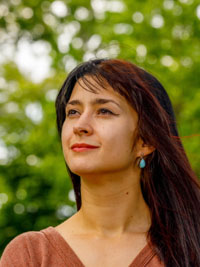
Zara Surratt
Religious Studies
“My dissertation uses St. Francis Mission Boarding School to examine Catholic participation in Federal Indian Policy during the late 19th and early 20th century and the concurrent experiences of Native American youth. St. Francis was a Catholic boarding school for the Sicangu Lakota children of South Dakota's Rosebud Indian Reservation. It was established during a widespread attempt to block Catholic participation in assimilative education, which emphasized the destruction of Native American lifeways as a prelude to absorption into the U.S. mainstream.
First-generation Catholic immigrants, especially women refugees of Prussia's Kulturkampf, understood themselves to be assimilating students into an American mainstream and a Catholic universe. I argue they simultaneously Americanized themselves, using educational labor to practice new citizenships. Their response to exclusionary rhetoric was to lean into assimilatory education—establishing themselves as American without abandoning Catholicism. Ironically, these subjects practiced similar strategies against Indigenous children, enforcing cultural change in the pursuit of assimilation.
Study of sources from the Bureau of Catholic Indian Missions reveals a location where diverse subjects drew upon their knowledge and practice to resist abuse and reassert agency, producing a myriad of unexpected identities.”
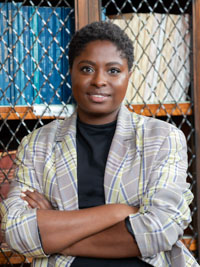
Zari Taylor
Communication
“This dissertation in Cultural and Platform studies examines racial dynamics of the creator economy in the United States. Specifically, I focus on the issue of Black content theft and appropriation—what has been called techno-minstrelsy. While minstrel shows have a specific history in American and Western popular culture, newer technologies enable the continuation of practices of appropriation in online spaces that reproduce racialized economic logics. I'm interested in how "ideal" white users can copy and perform racialized aesthetics — playing on America's appetite for Black culture while continuing to reject the Black people. I frame this historical practice within Beauty capital, which theorizes the importance, economic capacity, and racial implications of beauty.
Whiteness has long functioned as the norm of beauty, meaning white people, particularly white women, are automatically designated as beautiful and given various economic, social, and cultural benefits. In this project, I contend that the overt and subtle racial transformations of white and non-Black users online rely on their beauty capital which privileges them within the influencer industry. Though much has been written on the ways that Whiteness and beauty have created aesthetic hierarchies, scholarship on influencers—while critiquing neoliberal and meritocratic logics that especially account for gender and labor—have often failed to consider the importance in light of the disparities around race. Therefore, the goal of this project is to bridge this gap.”
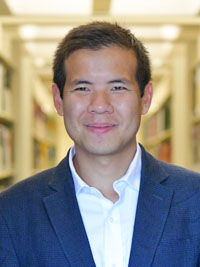
Pasuth Thothaveesansuk
History
“My dissertation looks at the history of liberal internationalism in East and Southeast Asia during the 20th century. I'm interested in this because it offers a lens into understanding the role Asian statesmen and diplomats played in the reorganization of the world after World War II. Much of my dissertation revolves around the establishment of the United Nations in 1945.
Through this international history project, I hope to incorporate viewpoints from all over the world. I plan to do research in archives all over the world that have holdings of original documents in many different languages. I plan to work in archives in the United States, the United Kingdom, Germany, Switzerland, Taiwan, and potentially Singapore, India, and the Philippines. I'm trying to cast a wide net to make this a truly global story.”
Read more about Pasuth Thothaveesansuk's Summer Research Fellowship Experience.
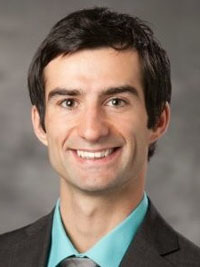
Tibor Vegh
City and Regional Planning
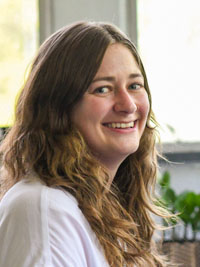
Taylor West
Psychology and Neuroscience
“I initially came to Carolina to work with Barbara Frederickson [Kenan Distinguished Professor and director of the Positive Emotions and Psychophysiology Lab at UNC-Chapel Hill] on emotion and well-being. She has developed a new theory on shared positive emotions as a marker of social connection. I quickly became interested in understanding shared positive emotions between strangers. I was interested in how, especially coming out of COVID-19, we connect with the people in our community.
Right now, I'm researching how positive interactions with strangers and acquaintances can lead you to be more open and kind, particularly toward people you may be dissimilar to. Some of my studies look at political opponents and another study looks at disagreeing colleagues in the workplace, but I don't think it's isolated to those contexts. It's the idea that more exposure to broad perspectives when meeting different people will make you generally more kind.”
Read more about Taylor West's Summer Research Fellowship Experience.
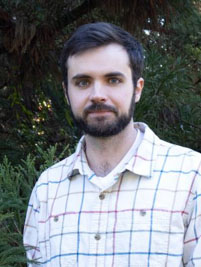
Jordan Williamson
English and Comparative Literature
“Over the last quarter of the nineteenth century, economic theory largely shifted from an emphasis on the scene of production to the world of consumption as it attempted to represent and understand an increasingly complex, abstracted economy. The new focus on consumption was underpinned by theorization of the consumer, and particularly of consumer perception. At the same time, parapsychological research into the supernatural shifted from an emphasis on the ontological reality of supernatural phenomena to the extreme mental states in which these phenomena might be perceived.
These shifts in the disparate fields of economics and psychical research, my dissertation argues, are brought into dialectical motion by the period's literature. American literature in the second half of the nineteenth century both illuminates an occulted supernatural logic within the economic world, and leverages this supernatural presence to try to imagine different economic relations. Writers like Henry James, Pauline Hopkins, Stephen Crane, Charlotte Perkins Gilman, Mary Wilkins Freeman, and Charles Chesnutt turn to the techniques of psychical research and popular spiritualism—crystal gazing, automatic writing, mesmerism, trances—to explore extreme mental states that heighten the work of what the economist John Bates Clark terms the "consumer sensorium." Reading the economic and the supernatural through one another, my dissertation argues that the supernatural literature of the period affords crucial means to reimagine the economic world, rather than simply rendering it realistically.”
